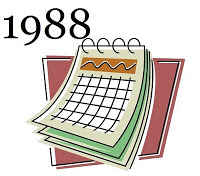
In going through some notes and records from 1988 I was surprised how much things have changed in the two decades and several years since then. It was interesting to review the “good old days,” assuming that they were good. Actually, we all had a good time back then, or at least I remember it that way.
Our first computer arrived early in the year, but hardly anyone knew how to use it. Great skill was required in programming, as all files had to have specially keyed instructions to operate MS-DOS. We all thought that computers would be very effective, but did not quite know in what way. In the meantime, on my own I had a Macintosh computer, which was easy enough to use—as it had a window-screen with icons, something not available with IBM and related products. Saving a file took quite a bit of time. While this was happening, you could leave the room and have a cup of coffee, or do something else. I am referring to a file that today would be considered short, such as for a book chapter or an article.
Al Gore had not invented the Internet yet, and thus there was no such thing as e-mail. Or, if there was, I didn’t know about it. All correspondence came and went through the postal service, except for some dealers who had fax machines, themselves a rather new gadget. By October the fax was so popular that a memo was sent around to our staff to add our fax number to all catalogues, order blanks, and anything else bearing our regular telephone number.
Walter Breen’s Complete Encyclopedia of U.S. and Proof Coins came out in 1988, and we ordered copies by the thousands. Everyone clamored to have a copy, providing for the first time a veritable numismatic library between two covers. All told, we sold over 10,000 copies in the next several years.
“Slabs” were relatively new, the first popular versions having been launched by PCGS in 1986 and then NGC in 1987. I came across quite a bit of correspondence with customers and other dealers as to whether serious numismatists should collect coins in slabs. Several people wrote to us saying that if we handled slabs they would not do business with us at all!
A few newcomers said they really liked slabs. Dealers liked them as well, and we found that a slabbed coin was apt to sell more quickly than one that was not. At the time a dealer selling a “raw” coin graded, say, MS-65 to a customer might get a letter a week later, to this effect: “I took it to Sam’s Coin Shop and he said it was only MS-63. I want my money back.” Dealers found that slabs ended complaints. If a coin seemed to be below par, it was the grading service’s fault. I found it curious that a coin could be overgraded (in my opinion) and as ugly as a toad, but if it was certified as MS-65, everyone believed it. Very curious (and still curious today).
In time, slabs made it possible for anyone to become a “professional numismatist.” No expertise needed! Of course, this was not really so, but the model worked just fine, as many buyers lacked expertise as well, and did not know the difference.
The coin market was sluggish in 1988, all over America there were bank failures, and the future seemed uncertain. Investors were relatively few in the marketplace, but collectors kept collecting, as they always do. In hindsight today over 20 years later, it was a very good time to buy coins, tokens, medals, and paper money. No one knew that coin investment, as mostly limited to “investment grade” MS-65 and Proof-65 coins, would skyrocket to heights never before seen, reaching an apex in 1990. But, that’s another story.





